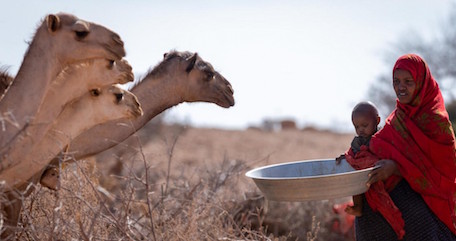For three years in a row, the rain has refused to fall in Ethiopia. Water wells are dry; crops and livestock are dead and dying. In the lowland regions of Afar, Oromia, The Southern Nations, Nationalities, and Peoples’ (SNNPR) and Somali, drinking water is in short supply; food security is deteriorating rapidly. Ethiopia’s worst drought in recent history is pushing families to the brink.
In Sagalo village, Kebridahar woreda, Somali region, Hafsa Bedel fears that she will lose more livestock in the coming months. “We are just one month into the long dry season (Jilaal), and I have already lost 25 goats and sheep,” said the mother of six. “I also lost four camels. There is no pasture, and our animals are suffering. I can’t afford to feed them corn. We don’t even have enough for us.”
She is struggling to save the lives of her family’s remaining camels, keeping them close to home so that her husband can bring water from a birkah (water well) where the government rations water. “If I let them [the camels] go, they wouldn’t find food and water,” she said. “They are still young.”
At dusk on January 21, 2022, in Gebi’as village, Somali region, Ethiopia, sixth grader Abdurazak Mohammed takes his donkeys back home, past the bodies of animals dead from thirst and starvation. His school is now closed due to the drought. “Many families sent their children with their cattle,” he said. “The teachers also left. Then the school is closed. I feel sad to see my school closed. I want to be a teacher when I grow up.” © UNICEF/UN0583950/
Livestock are dying in the fields
Cows, sheep, goats, camels and donkeys are dying in the fields from lack of food and water. The number of children suffering from malnutrition is on the rise.
“The impact of the drought is devastating,” said Gianfranco Rotigliano, UNICEF Ethiopia Representative. “Children and their families are struggling to survive due to loss of livelihoods and livestock. It is projected that more than 6.8 million people will be in need of urgent humanitarian assistance by mid-March 2022. We are also witnessing major displacement out of affected areas.”
Women and children walk past animal carcasses in Sagalo village, Somali region, Ethiopia as strong wind blows dust everywhere on January 21, 2022. © UNICEF/UN0583942
Children are dropping out of school to look for water
The dust is everywhere in Somali and Oromia, two of the hardest hit regions. More than 155,000 children in Somali and Oromia have dropped out of school so they can help fetch water — often travelling long distances — or look after other children while their caregivers try to find water for their families and cattle. Children who are out of school are at risk of exploitation or are being pushed into dangerous coping mechanisms.
Ten-year-old Bukhari Aden has never been to school. He spends his days looking after his family’s camels and fetching water. “In our village, the children are responsible to look after the animals,” he explained. “There is no water near the village. If we had water available nearby, it would be easy for me to go to school.”
10-year-old Bukhari Aden runs after his family’s camels after the animals have found water near Beda’as kebele, Shebele zone, Somali region on January 18, 2022. © UNICEF/UN0583967/
UNICEF is working with local authorities to provide lifesaving assistance to families in desperate need
UNICEF is working in close coordination with the local authorities to provide lifesaving assistance to those desperately in need. Priorities include:
- rehabilitating water systems and boreholes to ensure access to safe water for communities affected by drought
- dispatching emergency water trucks and providing water for livestock
- screening and treating severely malnourished children; distributing Ready-to-Use Therapeutic Food and vitamin A supplements
- procuring and distributing emergency drug and midwifery kits
- scaling up deployment of mobile health and nutrition teams; rehabilitating health centers and building capacity
- providing emergency education, supporting the reopening of schools and providing educational supplies
- scaling up child protection services, particularly for children who are not in school
A nurse measures Nimo Abdi Dhuh’s arm circumference with a pediatric MUAC (Mid-Upper Arm Circumference) bracelet. Two-year-old Nimo is receiving treatment for malnutrition at a UNICEF-supported mobile clinic in Barare village, Higloley Woreda, Somali, Ethiopia. © UNICEF/UN0583940/
At a UNICEF-supported mobile health clinic in Barare village, Higloley Woreda, Somali, Shamis Dhire looks on as a nurse measures her 2-year-old daughter’s mid-upper arm circumference. She is being treated for malnutrition. “We have been affected by the drought. We don’t have milk to give to the children,” said Dhire. “My child is sick due to lack of milk and food, and this happened because of the drought. Here, she has been given medical treatment. People have been harmed by the drought; our neighbors are affected the same way. Our cattle have been harmed by the drought. We have lost so much…. We pray to Allah for rain.”
We have lost so much … We pray to Allah for rain.
In Oromia region over the next six months, UNICEF and partners will scale up nutrition screening campaigns and provide nutritional support for 1.5 million children under 5. In Somali region, the target is 875,000 children. In the first half of 2022, UNICEF and partners are aiming to reach 1.1 million people in drought-impacted areas of Oromia with water, sanitation and hygiene services. To date, UNICEF has reached 600,000 people with safe water.
UNICEF is appealing for $31 million to meet the needs of more than 2 million people affected by the drought in Afar, Oromia, SNNPR and Somali regions. Please donate.
Top photo: In Ethiopia’s drought-stricken Somali region, Hafsa Bedel, is trying to keep her family’s camels alive. The mother of six has already lost 25 goats and sheep; with little access to food or water, she fears that she will lose more livestock in the coming months, jeopardizing her family’s livelihood and future. © UNICEF/UN0583934/
